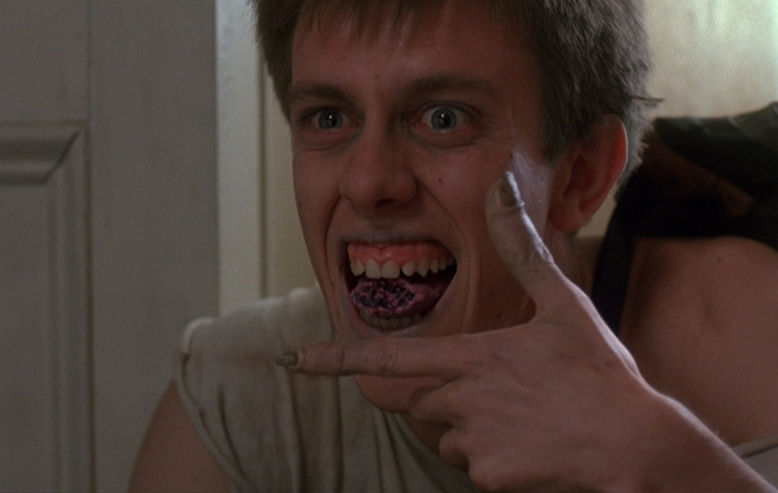
Almost every great director is known for having a few stinkers on their resume to go along with the masterpieces, but today I'm highlighting some movies with reputations that, undeservedly, seem to fall somewhere in the middle. Maybe they've just gotten lost in the mix with the classics, but these movies are often almost as good — if not as good — as the directors’ best work, and are always worth a second (or third) viewing.
John Carpenter: Prince of Darkness (1987)
What’s it’s about: A bunch of physics graduate students spend a few nights in a church to research the weird coded messages emanating from it. They find a cylinder of green neon goo in the church’s basement, which is Satan! It gets released and turns them into nasty zombies.
Why it didn’t become a widely beloved horror classic: Some read it as pretentious, slow, overly-philosophical, incomprehensible, or just too weird. Its opening credits are really long (as Sean Clark hilariously lampoons on his Horror’s Hallowed Grounds episode devoted to the movie, available on Scream Factory’s Collector's Edition). Also, its widescreen compositions were destroyed by MCA/Universal’s overly dark, pan and scan VHS tape, on which many horror fans discovered the film.
Why it’s great: Prince of Darkness is slow and weird in all of the right ways. Its weird philosophies — about the correlation between Satan, computer data and various levels of consciousness — is thought-provoking and interesting, if obscure. Every shot of the film is like a gorgeous painting, and there's a lot of amazing surrealist imagery (Satanic beetles eating a body from within! Mirrors as portals to other dimensions!). The film would be shown in film courses everywhere if it had been made in Germany in 1923. Its score, by Carpenter, is utter perfection — as brilliant as any score he ever composed. The church that serves as the film’s main location is unbelievably spooky and atmospheric. I can go on forever. This movie provides a master class in how to use film style to build dread. Carpenter’s more famous Halloween, although flawless, has lost some of its ability to scare because so many people have imitated it. Prince of Darkness is as scary as ever, because there’s never been anything else like it.
Wes Craven: The People Under the Stairs (1991)
What it’s about: Fool, a young boy from the inner city, breaks into his miserable landlords’ house to steal their expensive coin collection. They deserve it. They want to evict him and his mother who is dying of cancer because she can’t pay their increasingly unreasonable rent. Fool gets trapped in the house, which is a virtual anti-funhouse of traps and horrors. He befriends the landlords’ abused daughter and gets help escaping from the kidnapped, deformed prisoners that live in the house’s walls.
Why it didn’t become a widely beloved horror classic: I suspect that The People Under the Stairs didn’t really catch on because audiences who loved the glossy, palatable horrors of A Nightmare on Elm Street (1984) weren’t ready for Craven to return to the seriously twisted family dynamics and psychosexual perversity that permeated his ‘70s films. The movie’s extremely weird which, inexplicably, turns off a lot of people. It’s also a bit too over the top to really generate scares. Watching it now, it’s almost hard to believe that it played in malls.
Why it’s great: Um, read the paragraph about why people didn’t like it. Craven returns to the graphic depiction of American culture’s corruption and perversity that he examined overtly in The Last House on the Left (1972) and The Hills Have Eyes (1977) (and more subtly, although no less intelligently, in Nightmare). Craven’s anger at the wealthy’s tendency to exploit the impoverished and disabled is palatable and more relevant than ever. The film serves up a pretty awesome gallery of the grotesque (from the mutants living under the stairs to the movie’s super-creepy villainous landlords, played by Twin Peaks’ Everett McGill and Wendy Robie). It might not be that scary, but horror movies don’t need to be scary if they have so much else to offer.
Dario Argento: The Cat O’Nine Tails (1971)
What it’s about: A blind man, a young girl and a reporter try to uncover a series of murders surrounding a genetics lab. In doing so, they attract the wraith of the killer.
Why it didn’t become a widely beloved horror classic: Sophomore slump. The Bird with the Crystal Plumage (1970) created a sensation with its chic, extremely tense and surprisingly violent murderous set pieces. The Cat O’Nine Tails is more of a cozy mystery than a slasher film, and Argento has complained that his American producers made him tone down some of the stylistic flourishes that he loved. For fans who discovered Argento through his later, super expressionistic masterpieces like Deep Red (1975) and Suspiria, The Cat O’Nine Tails can seem even more tame and underwhelming.
Why it’s great: The Cat O’Nine Tails may be a cozy murder mystery, but it’s a really clever, absorbing, highly lovable cozy murder mystery. Also, even though it’s not as stylistically wild as some of Argento’s other movies, even a “toned down” early Argento film still has more wow-inducing cinematography than most other films that came before or after. Plus, James Franciscus is cool as ice as the enterprising journalist. He makes drinking milk sexy. Could you?
Lucio Fulci: The Psychic (1977)
What it’s about: Virginia, a psychic, sees a vision that leads her to break down a wall in her house, where she finds a skeleton. As she and her psychiatrist try to solve the mystery, she has a vision of her own murder!
Why it didn’t become a widely beloved horror classic: Anybody expecting one of Fulci’s grandiose zombie epics would be disappointed by this restrained giallo (for those who don’t know, giallo basically means a lurid Italian thriller involving murder).
Why it’s great: Fulci’s devoted fans know that he was just as adept at making tautgialli as he was at making gory spectacles. In the last few decades, his giallo Don’t Torture a Duckling (1972) has become regarded as something of a classic. Possibly because it’s harder to find, The Psychic hasn’t gotten as much attention. Fulci builds suspense masterfully, and keeps you guessing with each twist. The film’s psychic visions are surreal and creepy, as is the “seven black notes” music box melody that accompanies them (which Quentin Tarantino, a fan of the film, later appropriated in Kill Bill Volume 1). You will not forget the ending.
James Wan: Dead Silence (2007)
What it’s about: A man returns to his hometown hoping to solve his wife’s murder, which might have been at the hands of a scary-ass ventriloquist’s dummy.
Why it didn’t become a widely beloved horror classic: It went against the tide of its times. Dead Silence was Wan’s follow up to Saw, which started the “torture porn” horror trend that was still going strong in 2007. Apparently audiences weren’t in the mood for a classic gothic horror yarn about the evil ghost of a ventriloquist and a haunted town.
Why it’s great: Well, for one thing, it’s terrifying. I will never forget going to see it in an empty theater, expecting nothing, and having my jaded horror fan s#$% scared out of me. Also, it’s beautiful. Its smoky, shadowy imagery recalls gothic classics like Black Sunday (1960), City of the Dead aka Horror Hotel (1960), and Something Wicked This Way Comes (1983). Wan fills the screen with creepy dolls, weird antiques, and other ominous stuff. Mary Shaw, the evil, vengeful ventriloquist at the center of the mayhem, is as freaky and threatening a villainess as I’ve ever seen. So much about this film foresees the wildly successful Insidious, which blissfully brought back the supernatural horror film. I love Insidious, but I love Dead Silence more. If we had gotten Dead Silence as the follow up to The Conjuring (2013) instead of Annabelle (2014), I suspect that it would have been a big success and become known as one of the greats.
Joe Dante: The Hole (2009)
What it’s about: Two brothers, bummed out after leaving NYC for a small town, discover a big, locked trap door in their basement. When they break through the padlocks and discover a deep hole, their worst fears come true. What’s in…the hole?!
Why it didn’t become a widely beloved horror classic: I suspect we have a case of weak distribution. On his Trailers from Hell entry devoted to the film, Dante mentions that it had a hard time reaching American audiences, even though it was well-received in Europe. Even though I adore Joe Dante, I wouldn’t have even heard about The Hole if the kind folks at the blog Kinder Trauma hadn’t called it a must see and pointed me to Netflix (if you want a bottomless well of underrated horror movie recommendations, visit them daily). Also, it’s not scary in a big, bad way, but that obviously wasn’t Dante’s intention.
Why it’s great: Nobody gets nostalgia like Joe Dante. For horror fans that grew up with video store classics like The Gate (1987) and TV shows like Tales from the Darkside and Are you Afraid of the Dark?, The Hole will deliver the priceless feeling that accompanied formative horror experiences. Like those movies and TV shows, it’s also the perfect gateway movie (har har) for young horror fans.
Dan Curtis: Night of Dark Shadows (1971)
What it’s about: A brooding artist and his perky wife move into his family home, only to find themselves plagued by Angelique the witch!
Why it didn’t become a widely beloved horror classic: Oy, where to begin. The zeitgeist moment of the classic supernatural soap opera had come and gone (although, for obsessed fans like me, it would go on forever). Unlike the film’s predecessor, House of Dark Shadows (1970), Night… had little to do with the TV series’ plots or characters (except, of course, Angelique!). MGM forced Dan Curtis to cut about 45 minutes from what was, by many accounts, a masterpiece, creating some big plot holes in the film. The cuts forced Curtis to end the film with an unintentionally hilarious post-script that gets typed across the screen, telling us what happened to its characters. A lot of problems.
Why it’s great: House of Dark Shadows may have been true to the series, but it doesn’t make a lick of sense to somebody who isn’t already familiar with the show. Night of Dark Shadows more or less stands on its own as an effective horror film. Although Curtis abandoned most of the series plotlines and characters, he still happily brought back many of its beloved stars. The always wonderful Grayson Hall shines as the mansion’s spooky caretaker. Her caftans alone make the movie worth purchasing. While it’s obvious that the movie was heavily cut, it still has a haunting, lyrical quality that has won the devotion of many fans, including some who have been making great efforts to restore the film for years. Finally, while Dan Curtis proved that he could scare us with the series Dark Shadows and later The Night Stalker (1972), Trilogy of Terror (1975) and Burnt Offerings (1976), the Dark Shadows movies proved that he had a keen visual sense. Both Dark Shadows movies were long plagued by mediocre VHS and laserdisc transfers. Their recent Blu-ray releases show that Night of Dark Shadows is among the most beautiful horror films of the ‘70s.
George Romero: Season of the Witch aka Hungry Wives (1972)
What it’s about: A bored housewife dabbles in witchery, with terrible consequences!
Why it didn’t become a widely beloved horror classic: Okay, I’ll admit it. Night of the Living Dead (1968) it ain’t. This is not a gritty, unrelentingly intense, shockingly gory horror masterpiece. Rather, it uses elements of horror and surrealism to create a second wave feminist character study. Not exactly a typical fanboy’s dream.
Why it’s great: Season of the Witch may not be a typical fanboy’s dream, but it is mine. Romero serves up an awesome portrait of suburban life in 1973, with a hefty dose of witchy wonder! Also, this is the only horror movie containing a monologue in which a housewife deconstructs her body image issues and a montage set to a song by Donovan. We are grateful.
Ben Raphael Sher is VP of Development at XG Productions LA, Inc. He holds a PhD in Film, Television, and Digital Media from UCLA, where he teaches. He also writes for Chiller TV (http://www.chillertv.com/friday13), SyFy (www.syfy.com), and his blog, Eyes of Ben Sher (http://eyesofbensher.blogspot.com). He is a regular co-host of the Retro Movie Love podcast (http://retromovielove.com).









